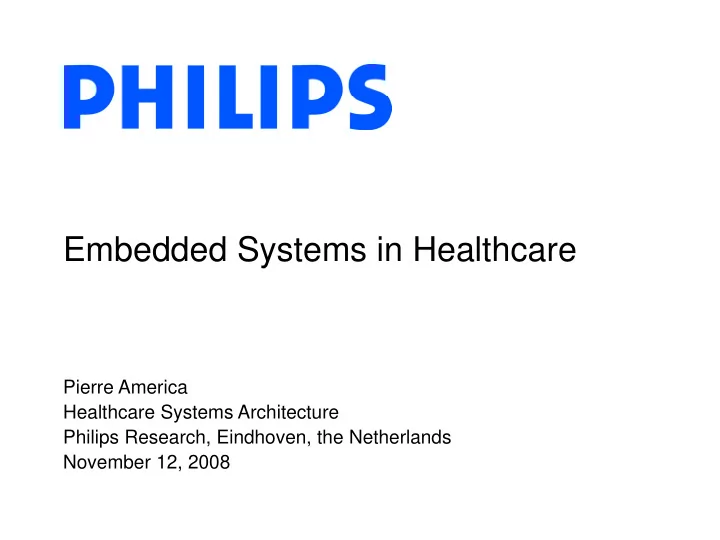

Embedded Systems in Healthcare Pierre America Healthcare Systems Architecture Philips Research, Eindhoven, the Netherlands November 12, 2008
About the Speaker • Working for Philips Research since 1982 • Projects for Philips Healthcare (formerly Philips Medical Systems) since 1996 – X-ray – Magnetic Resonance Imaging – Electrophysiology • Areas of research: – Software and system architecting – Domain modeling – Product families – Scenario-based architecting – Evolvability 2 Philips Research Eindhoven, Pierre America, November 12, 2008
Systems in Healthcare • IT systems – Electronic Medical Records (across care providers) – Hospital Information Systems – Department Information Systems (e.g., cardiology, radiology, …) – Picture Archiving and Communication Systems – Clinical Decision Support Systems – … • Embedded systems – Diagnostic systems • Imaging systems • Monitoring systems – Interventional systems 3 Philips Research Eindhoven, Pierre America, November 12, 2008
Philips Portfolio •General X-ray •Cardio/Vascular X-ray •Ultrasound •Computed Tomography •Magnetic Resonance Imaging •Nuclear Medicine •Positron Emission Tomography •Healthcare Informatics •Radiation Therapy Planning •Cardiac and Monitoring Systems •Home Healthcare 4 Philips Research Eindhoven, Pierre America, November 12, 2008
Cardiovascular X-Ray • Makes images of blood vessels, by subtracting images with and without contrast fluid • High frame rates needed for cardiology • Often used in catheter interventions • Multiple projections needed – Biplane saves contrast fluid 5 Philips Research Eindhoven, Pierre America, November 12, 2008
Magnetic Resonance Imaging • Measures various parameters: chemical context, density, flow, diffusion, temperature, … • Useful for soft tissue imaging, e.g., nervous system • Supports functional imaging • No ionizing radiation 6 Philips Research Eindhoven, Pierre America, November 12, 2008
Ultrasound • Most cost-efficient imaging technology • Wide array of applications – Cardiology & Cardiac Surgery – Vascular Medicine – Obstetrics/Gynecology – Radiology 7 Philips Research Eindhoven, Pierre America, November 12, 2008
Remote Patient Monitoring • Measuring devices at patient’s home (or even mobile) • Network connection to service center • Web-based clinical software to monitor a large number of patients efficiently 8 Philips Research Eindhoven, Pierre America, November 12, 2008
Technology Characteristics • Example: MRI Programming Languages C, C++/STL, C#, Visual Basic, ASP, JavaScript, Perl, Batch, and other proprietary languages Persistent Storage RDBMS, flat files, indexed and sequential Files, XML Inter-process communication Socket, COM, shared memory, shared files Source Code Size ~8 MLOC in ~30 000 files Timing accuracy Scanning hardware: nanoseconds Real-time software: 1 millisecond User interaction: 0.1 – 1 second 9 Philips Research Eindhoven, Pierre America, November 12, 2008
Generic Requirements • Safety – Protection from physical hazards: radiation, voltage, heat/cold, moving parts – Sterizability and resistance to various fluids – Avoidance of clinical errors • Ease of use – Easy to learn (not only for experienced radiological operators) – Efficient in routine use – Optimal support for clinical workflow • Image and signal quality – The best images or signals you can get – Easy to control – Reproducible • Connection to clinical infrastructure (HIS, PACS, CDSS, EMR …) 10 Philips Research Eindhoven, Pierre America, November 12, 2008
Trends • Cost reduction • Feature race – Resolution (2D, 3D, 4D) – Speed – Number of channels, slices, … • Multimodality • Imaging aspects: anatomical � functional � molecular • Mixing of control and content: Imaging and monitoring systems are more aware of what they see 11 Philips Research Eindhoven, Pierre America, November 12, 2008
Challenge: Performance • Especially relevant for imaging systems • Data rates are increasing tremendously • Processing algorithms are getting more sophisticated – Removing artifacts (noise, scattering, absorption, movement, …) – Image analysis • Ease of use requirements lead to more advanced user interfaces • CPU clock speeds are hardly increasing 12 Philips Research Eindhoven, Pierre America, November 12, 2008
Challenge: Performance Response: • Better performance modeling and optimization – High-level models based on measurements • Parallel computing – Graphical cards (SIMD) – Multi-core computers – Clusters – Grid computing 13 Philips Research Eindhoven, Pierre America, November 12, 2008
Challenge: Medical Informatics goes Embedded • The medical world has gathered an enormous mass of knowledge. • The knowledge is available via a very heterogeneous set of sources: – Classifications (SNOMED, ICD, …) – Scientific articles/abstracts (PubMed, …) – Clinical guidelines (NGC, …) – Genomics and proteomics databases (EMBL-EBI, …) – Image databases (typically local only, via DICOM) – Pathology databases (typically local only) – Clinical trials (open to participant organizations) • Medical equipment is more and more expected to – take this knowledge into account – make it accessible to its users. 14 Philips Research Eindhoven, Pierre America, November 12, 2008
Challenge: Medical Informatics goes Embedded Responses: • Medical Informatics – Service-Oriented Architectures – Data access wrapping/conversion services – Ontology modeling and matching – Anonymization and pseudonymization services • Additional for embedded systems: – Runtime updating/upgrading 15 Philips Research Eindhoven, Pierre America, November 12, 2008
Challenge: Systems of Systems • Medical systems (almost always) operate in a context of other systems. • Users expect one integrated system, but currently have to deal with heterogeneous subsystems – Catheterization lab • Cathlab for electrophysiology – Operating room – … 16 Philips Research Eindhoven, Pierre America, November 12, 2008
Challenge: Systems of Systems Responses: • Integration techniques – Physical – Data – Presentation and control – Workflow • Multilevel, heterogeneous modeling • Analysis and design techniques for robustness 17 Philips Research Eindhoven, Pierre America, November 12, 2008
Challenge: Evolvability • Complexity of systems is high and increasing – Inherent complexity – Heterogeneity – Historical growth – Complex multidisciplinary development organization • Many sources of changing requirements – Customer context (clinical applications and workflow, neighboring systems, legislation, reimbursement, …) – Technology: generic (operating systems, …) or domain-specific (new MRI gradient amplifiers, solid-state X-ray detectors, …) – Business (business model, competition, organization, …) • Development budgets are not increasing How to adapt to these changing requirements with limited, predictable effort, within limited time, and while maintaining critical quality attributes? 18 Philips Research Eindhoven, Pierre America, November 12, 2008
Challenge: Evolvability • Responses: 19 Philips Research Eindhoven, Pierre America, November 12, 2008
Recommend
More recommend